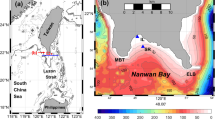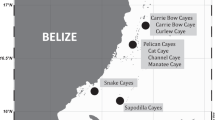Summary
Several polar continental air masses intruding into the south Florida/northern Bahama Bank region during January 1981 caused record low air temperatures and rapid chilling of extensive shallow-water carbonate systems. Numerous “coral kills” along the Florida reef tract and massive fish mortalities in Florida Bay were attributable to unusually cold waters generated at this time. Thermal evolution of Florida Bay/Florida reef tract and northern Bahama Bank waters from 8 to 21 January was assessed from thermal infrared data acquired by the NOAA-6 environmental satellite, in situ water temperatures, local meteorological data, and a computerized heat flux model. Field observations and laboratory experiments identify 16°C as a thermal stress threshold for most reef corals (Mayor 1915; Davis 1981). Temperaturecorrected digital satellite data indicated that water temperatures below 16°C were generated in Florida Bay and on Little and Great Bahama Banks during a 10-day period in January. Lowest temperatures on the Florida reef tract resulted from offshelf transport of Florida Bay water through major tidal channels. Offshelf movement of bay water is driven primarily by strong northerly winds, density gradients, and tidal pumping. Absence of reef development opposite major tidal passes along the Florida reef tract (Ginsburg and Shinn 1964) and aperiodic coral kills along bank margins can be attributed to this process, which has probably had a limiting influence on Holocene reef development in these areas.
Similar content being viewed by others
References
Davis GE (1981) A century of natural change in coral distribution at the Dry Tortugas. Bull Mar Sci (in press)
DiRosa D, Huh OK (1980) The LSU calibration program for the advanced very high resolution radiometer (AVHRR) of TIROS-N/NOAA series of environmental satellites. Unpublished manuscript, Louisiana State University, Baton Rouge, 51 pp
Ginsburg RN, Shinn EA (1964) Distribution of the reef-building community in Florida and the Bahamas. Am Assoc Petrol Geol Bull 48:527 (abstract)
Hsu SA, Rouse LJ, Huh OK (1976) Comparison of onshore and offshore radiosondings and the correction of sea-surface temperature from satellite infrared measurements. Proc 4th Symposium on Meteorological Observations and Instrumentation, pp 166–171
Hudson JH (1981) Growth rates in Montastrea annularis: a record of environmental change in Key Largo coral reef marine sanctuary, Florida. Bull Mar Sci 31:444–459
Hudson JH, Shinn EA, Halley RB, Lidz B (1976a) Autopsy of a dead coral reef. Am Assoc Petrol Geol Bull 60:682 (abstract)
Husdon JH, Shinn EA, Halley RB, Lidz B (1976b) Sclerochronology: a tool for interpreting past environments. Geology 4:361–364
Kidwell KB (1979) NOAA Polar orbiter data (TIROS-N) users' guide, preliminary version. Satellite Data Services Division, National Climatic Center, Washington DC, 134 pp
Lighty RG (1977) Relict shelf-edge Holocene coral reef: southeast coast of Florida. Proc 3rd Int Coral Reef Symp, Univ of Miami, pp 215–221
Lighty RG (1981) Fleshy-algal domination of a modern Bahamian barrier reef: example of an alternate climax reef community. Abstracts 4th Int Coral Reef Symp, Manila, Philippines 18–22 May, p 37
Lighty RG, MacIntyre IG, Stuckenrath R (1978) Submerged early Holocene barrier reef south-east Florida shelf. Nature 275:56–60
Marszalek DS, Babashoff G Jr, Noel MR, Worley DR (1977) Reef distribution in south Florida. Proc 3rd Int Coral Reef Symp, Univ of Miami, pp 223–229
Mayor AG (1914) The effects of temperature on tropical marine animals. Carnegie Inst Washington Publ 183 6:1–24
Mayor AG (1915) The lower temperature at which reef-corals lose their ability to capture food. Yearbook Carnegie Inst Washington, vol 14, 212 pp
Roberts HH, Rouse LJ Jr, Walker ND, Hudson JH (1982) Cold water stress in Florida Bay and Northern Bahamas: a product of winter cold-air outbreaks. J. Sediment Petrol 52:145–155
Shinn EA (1976) Coral reef recovery in Florida and the Persian Gulf. Environ Geol 1:241–254
Vaughan TW, Wells JW (1943) Revision of the suborders, families and genera of the Scleractinia. Geol Soc Am Spec Pap 44:55–56
Voss GL (1973) Sickness and death in Florida's coral reefs. Nat Hist 72:41–47
Author information
Authors and Affiliations
Rights and permissions
About this article
Cite this article
Walker, N.D., Roberts, H.H., Rouse, L.J. et al. Thermal history of reef-associated environments during a record cold-air outbreak event. Coral Reefs 1, 83–87 (1982). https://doi.org/10.1007/BF00301689
Received:
Accepted:
Issue Date:
DOI: https://doi.org/10.1007/BF00301689




